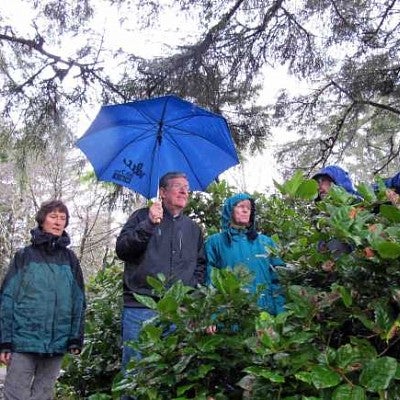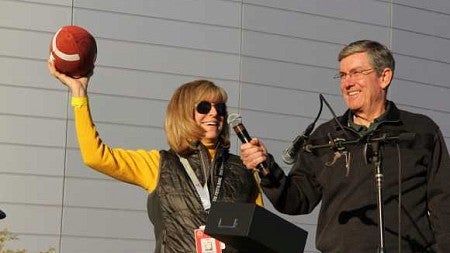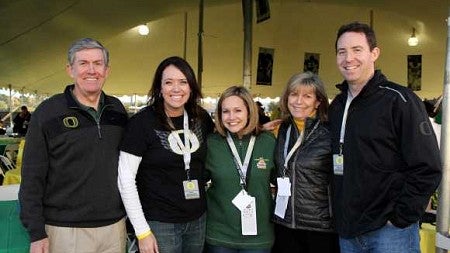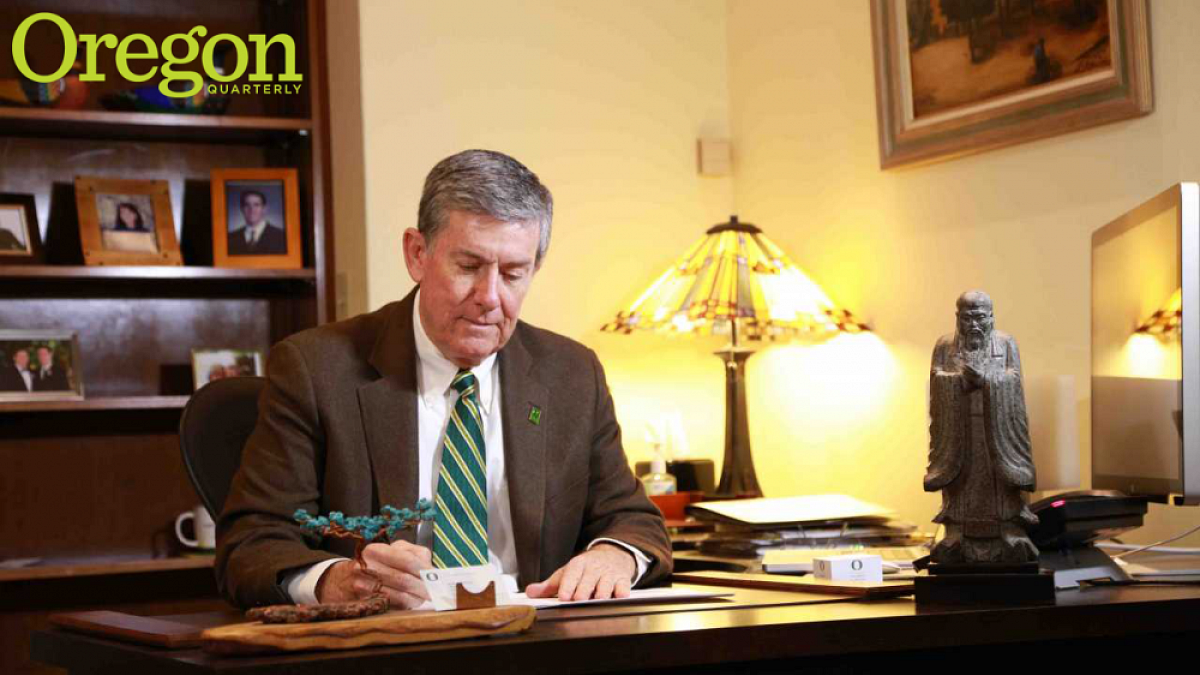Everybody talks about the weather. People everywhere do this, of course, as they angle for common conversational ground. But the topic receives special attention in western Oregon, a region defined by its climate. And that attention is heightened when a newcomer is involved, especially if that newcomer is a native Californian. So the day's mercurial weather—clear one minute, pouring the next—dominates the conversation among the faculty members gathered in the back room of the Excelsior, a restaurant near campus, on this November day. They sip their drinks, awaiting the arrival of the university's new president, and discuss the rain.
Michael Gottfredson has been on the job since August 1. Prior to coming to Oregon, he spent 12 years as executive vice chancellor and provost, and professor of criminology, law, and society, at the University of California, Irvine. Before that, he served in progressively senior leadership positions over a 15-year tenure at the University of Arizona, including interim senior vice president for academic affairs and provost, vice provost, and vice president of undergraduate education. When Gottfredson's appointment as the UO's 17th president was announced in June, his former colleagues were effusive in their praise, calling him "spectacular," "terrific," "in high demand," "a bastion of civility," "tough," "committed," "inspiring." They agreed that Oregon "hit the jackpot."
With just weeks to wrap up responsibilities at Irvine, pack, move, and complete a promised conference paper or two in his academic area of criminology, Gottfredson was on the go from the moment he arrived in Eugene. He immediately launched into an ambitious schedule of traveling around the state and beyond, meeting with alumni, business and community leaders, legislators, and peers within the Oregon University System. So he welcomes the chance, on this damp autumn evening, to spend some time with the faculty of the sociology department, his academic home.
Gottfredson arrives, shakes the raindrops from his coat, and falls easily into conversation with his new colleagues. He listens more than he talks. As the faculty members sense his interest in their work, the discussion moves quickly from the weather to publishing, research, the work that currently engages them. Gottfredson came up through the faculty ranks—a less common path for university presidents than it once was—and he is at home in this crowd. He understands the passion and focus of academic discourse, the excitement of research, the joy of teaching. In his new role, he sees the challenges facing public higher education—reduced state appropriations, rising costs and student debt, growing skepticism about the value of a college degree—as opportunities to advance a much-needed reorganization of funding and governance systems.
* * *
A week later, the weather is again hogging the conversation. The president and his wife, Karol, are touring the UO's Oregon Institute of Marine Biology (OIMB) at Charleston, a tiny, coastal community near Coos Bay. The first stop is marine biologist Richard Emlet's lab, where Emlet and his graduate students are studying sea urchin larvae, looking for variations in evolution across species. Mia, the lab Chihuahua, growls at the president but wags her tail for Karol. "She likes double X chromosomes better than XY," quips the lab director.

Over lunch in the OIMB dining hall, students discuss the economic impact of their work on local industries, such as a study that has led to the creation of a successful prediction model of annual Dungeness crab populations. One of the most satisfying aspects of his job as president, Gottfredson says, is the unique perspective it offers on the vast scope of faculty and student accomplishments happening on a daily basis across departments, fields, and disciplines. While a graduate student at OIMB excitedly describes her work's potential for improving the bottom line of an urban fish farm, the president can see it in context with other research going on throughout the university. "The cumulative effect is stunning," he says, not only in terms of the advancement of knowledge, but in dollars and cents. Research-related activities at the UO generated $110.6 million in revenue last year, the vast majority of it from outside the state. "It just knocks your socks off."
After lunch, a high tide and choppy seas prevent a planned excursion on one of the UO's research vessels, so the group instead boards a state van for a tour narrated by Jan Hodder, PhD '86. Hodder's intimate knowledge of the coastline is informed by years spent studying and teaching here. As she steers the van around sharp curves and through muddy potholes, the president quietly assesses each passenger's seatbelt situation, interrupting Hodder's report of a recent cougar sighting to remind a young staff member to buckle up. The day concludes with a meeting at OIMB with state representative Caddy McKeown and, for the Gottfredsons, a long, rainy drive home to Eugene.
* * *
The degree to which his presence is required outside of Eugene, and even outside the state, is one of the things Gottfredson thinks might most surprise people about his job. "It's even surprised me a little bit," he admits. Much of his time is spent in Portland and Salem, working to move UO projects forward in the state's legislative process. A plan to renovate the Erb Memorial Union, which Gottfredson describes as "long needed," is currently under consideration, and a project to improve accessibility at Autzen Stadium is under way, scheduled for completion before the 2013 football season kicks off.
By far the most critical issue for the UO before the state legislature, says Gottfredson, is the creation of a new system of institutional governance. Currently, a central board governs the entire Oregon University System of seven universities. The UO and Portland State University are advocating for a new approach, one that enables universities to establish institutional public governing boards to strategically address the particular needs of each university. Gottfredson points out that this idea is not new, and did not originate with him, although the opportunity to lead the UO in the ongoing process was one of the things that most attracted him to the job. Dave Frohnmayer, UO president from 1994 to 2009, was active on the issue, authoring several concept papers that helped shape the discussion moving forward. Frohnmayer's successor, Richard Lariviere, lost his job after alienating the OUS chancellor and state board as he aggressively pushed his own "new partnership" vision for independent governance.
Gottfredson is as certain as his predecessor that a new governance model is necessary to preserve the University of Oregon as a premier public research university. But his style could not be more different. Oregon's previous president was known for his exuberant manner, his impatience, and the signature fedoras that he frequently wore. Soft spoken and contemplative, humble and analytical, Gottfredson possesses a dry wit and deadpan delivery. He is known for his reliability, for keeping his cool, and for getting things done behind the scenes. He keeps his salt-and-pepper hair trimmed neat, and favors traditional suits. (When asked to come up with something her husband was not good at, Karol Gottfredson thinks for a moment, then offers, "Well, he's not a fashionista.")

The establishment of an institutional board—which Gottfredson stresses would be a public board—would have two primary benefits, he explains. First, it would give the university flexibility. For example, recent enrollment growth—important to offset the financial impact of reduced state appropriations—has led to an acute space crunch at the UO. "But even if we agreed on a building today," Gottfredson says, "the quickest we could get a shovel in the ground is four years from now. So here we sit, in the most attractive borrowing environment in decades. We're very highly rated if we were to issue bonds. Construction costs are low. We need the flexibility to be a responsive organization," flexibility the current state process does not allow.
The second big benefit of an institutional board, he says, would be "the opportunity to associate a group of trustees with the university who have an intimate knowledge of the University of Oregon—the kind of university we are, our mission, our aspirations, what we do and how we do it." This affinity is important for attracting the intellectual and financial commitment of trustees, he says. "It's all about enhancing our ability to meet our mission."
Speaking to the City Club of Eugene one Friday in December, Gottfredson reminds the assembled group of elected officials, community and business leaders, and members of the media that the concept of public higher education underlies the very nature of a liberal democracy. "When Abraham Lincoln took time out from thinking about the Civil War to sign the Morrill Act of 1862, the legislation that created land-grant universities, he knew that higher education was the key to individual economic and social mobility—and as a consequence, to the economic prosperity of a society," says Gottfredson. "Access to it must not depend on status or station in life. It cannot be true that the highest quality educational experiences be available only to the upper class. He linked together the idea of access and quality, and made that bond one of the defining features of public education.
"If we still believe in the idea that access and quality are the twin pillars of the mission of public universities," Gottfredson continues, leaving no doubt that this is his firm belief, "then we need to develop alternatives to the states to finance our universities. It needs to be done differently, and it needs to be done now."
While Gottfredson is clear that he will never give up on state funding—and finds Governor Kitzhaber's support for state investment in education in his most recent budget proposals encouraging—he is also a pragmatist, noting that "there is no realistic basis for believing the state—here in Oregon or elsewhere—will be the solution to our dilemma. It's progressed too far." What's needed, he says, is creativity. New thinking and new solutions.
* * *
Karol Gottfredson sips tea in a small, cozy sitting room at McMorran House, the University of Oregon president's official residence since 1941. Craft projects and Dora the Explorer books offer evidence of a recent visit from the Gottfredsons' young granddaughters. The president's wife, who holds a master's in education from the State University of New York, Albany and has spent her career in K-12 education and administration, talks about the man she has known since they were about ten years old, taking lessons from the same piano teacher in Davis. Both are multiple-generation westerners. "We both grew up in families that had pioneers in their backgrounds," she says. "It sounds corny, I know, but there's something to the idea of that can-do, pioneer spirit, the idea that nothing is insurmountable. When the river's too high, you build a bridge across the river.
"Even though Michael didn't hold elected offices in high school," she continues, "he was always the go-to guy. He never gets rattled. He is methodical; he believes that you make a plan to fix things, and they will get done. He is always calm, and there is always a solution." As an administrator, she says, "He is very strategic—which is a different thing than being political. He always looks for a solid solution, not a quick fix. He doesn't jump on things quickly without a lot of thought." She pauses and adds, laughing, "Except marrying me. I don't know what happened there!"
The Gottfredsons were married in 1970, when both were undergraduates at UC Davis. They dated in high school, although neither can pinpoint a first date. "We shared the same group of friends," she says, "and it kind of evolved into dating." Karol remembers riding on the back of Gottfredson's motorcycle, a Honda 350 he shared with his four brothers. (One of those brothers—Stephen Gottfredson '71, now a professor at Virginia Commonwealth University—is a Duck).

This is not the first time Karol has lived in Eugene. Her father—who, as football coach at UC Davis, once coached a young player named Mike Bellotti—took a sabbatical at the UO in 1963, and the Schmalenberger family lived just blocks from McMorran House, the Gottfredsons' current home. "I went to Condon Elementary School, which is now the UO's Agate Hall," she says, noting that the family also spent several summers in Eugene. "One of my most memorable childhood moments was watching Rafer Johnson qualify for the 1960 Olympics at Hayward Field," she recalls. "He broke the record for the most points in the decathlon, and I ran down on the field afterward and got his autograph. That was huge to me, it was one of the highlights of my childhood." As proof, she produces a scrapbook containing the autograph, as well as ribbons she won for the 440 and shot put in All-Comers meets at Hayward Field.
* * *
The president is sitting in his office in Johnson Hall. He has been at the UO six months now. He has adjusted the office to his liking, painting a reddish-brown wall a straw color to lighten the room, and hanging artwork from the university's collections that provide a sense of place—semiabstract landscapes and images of fir forests in deep greens and golds. From his desk, he can see a light rain dripping from the trees outside. It's a welcome rain, finally washing away a stubborn inversion that held the Willamette Valley under a blanket of freezing fog for more than a week.
A granite statue of Confucius, about 18 inches tall, watches over the room from an end table. "Pick it up," suggests the president. It is heavy—shockingly heavy. He laughs. "I'll tell you the story of that Confucius," he says. "A former student of mine had gone on to teach at a university in Taipei, and invited me to visit. At lunch, the president of the university presented me with this statue of Confucius, the great teacher. As we know, teachers are very highly respected in Taiwanese culture and society. He told me they revere my student very much; he's a very prominent professor. They were delighted that the teacher of their teacher was at the university, so they presented this to me. It's one of my prized possessions."
There's a purity to the reverence for education, for knowledge, that the statue represents. Its weight and solidity, the human creativity and endeavor that coaxed it from a block of stone, seem symbolic of Gottfredson's view of the importance of the university. He often refers to the university as "a noble organization," using the word with absolute sincerity. "The University of Oregon is a premier public research university," he says, "and each of those words—'premier,' 'public,' and 'research'—is equally important. As such, our mission is to enhance the quality of life for people in the state, the nation, and the world. That's all we do. We don't have any other purpose. There are very few organizations that can say that."
—By Ann Wiens


